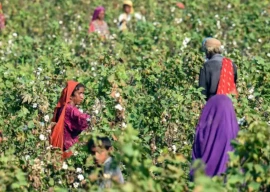
Following the passage of some 15 years and no fruition, various development plans, once enthusiastically pitched, exist today as little more than hollow words stamped in the budget books of the Sindh government.
“There are over 200 such schemes lying incomplete as of now,” revealed an official of the Sindh Planning and Development Department (P&D). “These include around 50 projects for education, 30 for local government, 28 for irrigation and 23 for public health engineering, as well as those for transport, sanitation and women empowerment.”
According to the official, these projects had been outlined for manifestation across Karachi, Hyderabad, Larkana, Jacobabad, Naushero Feroz, Ghotki, Mirpurkhas, Qambar-Shahdadkot, Umerkot and other districts of Sindh over a decade ago.
One such scheme, pertaining to the Sindh College of Arts and Design for Sukkur, was introduced to the budget books in 2013. “Despite being approved, seven years on, the project has shown no progress to hint at any intentions of completion anytime soon,” told the P&D officer, referencing various project records.
Per these records, the government had also tasked itself with building IBA Community Colleges in Jacobabad, Naushero Feroz and Umerkot - which, too, appear to be plagued by stagnation.
Likewise, model fishermen villages were originally envisioned in 2007, to be developed for Keenjhar, Manchar and other fishing districts of the province. But to date, the ghost scheme, which was also allocated Rs4.6 million in the current budget, has nothing to show for it on ground.
In 2008, the Sindh Education Department had developed an idea to upgrade its schools too. In this regard, around 230 middle schools were selected for upgradation to high schools, while 400 primary schools were to be converted into middle schools.
Although a budget was duly allocated, a dozen years later, the scheme remains pending till what appears to be the twelfth of never.
Much in the same vein, the new Sindh Secretariat project was also approved in 2012, to build two complexes to house government offices in Karachi. While the project’s estimated cost was noted as Rs9 billion, there exists not a single brick laid in the project’s name eight years later.
Following Benazir Bhutto’s assassination and the Pakistan People’s Party (PPP) coming to power in 2008, the government had announced it would build driver training schools across all of Sindh’s divisional headquarters. Although plans were devised and funds allocated for setting up schools in Hyderabad, Karachi, Larkana and Sukkur, this scheme too has been little but a pipe dream for the province’s people.
In addition, a decade ago, the government had also allocated funds to set up export processing zones in multiple districts, including Badin, Mirpurkhas, Shaheed Benazirabad, Hyderabad, Khairpur Mirs and Ghotki. “However, despite its inclusion in each fiscal budget thenceforth, the project is still incomplete,” revealed a source privy to the development.
Similarly, there are also various other schemes such as one for establishing bus terminals in Sindh, and others for the Shaheed Zulfiqar Ali Bhutto Engineering College in Memon Goth, Karachi Sindh University campus in Mirpurkhas, IBA Sukkur campus in Thatta, which still exist solely on paper with no real-world manifestations.
According to a senior P&D official, a monitoring and evaluation cell has been working within the wing to keep an eye on the progress of schemes. “That being said, the cell is mostly confined to kickbacks. Despite dozens of officials under the director-general’s command working towards quality assurance, the cell is a little more than a formality with no impact as such,” he alleged.
On the other hand, commenting on development funds, Sindh Information Minister Nasir Hussain Shah blamed the federal government for not releasing the funds from a divisible poll, which, according to him, has hindered the pace of development in Sindh.
“Most of our funds come from Islamabad, which has slashed our budget for several years. That is why many schemes are in the doldrums,” he insisted, maintaining that despite these financial constraints, Sindh has carried out comparatively more development work than the rest of Pakistan’s provincial governments.
Published in The Express Tribune, December 15th, 2020.









1736251113-0/Express-Tribune---News-Desk-(3)1736251113-0-270x192.webp)














COMMENTS
Comments are moderated and generally will be posted if they are on-topic and not abusive.
For more information, please see our Comments FAQ